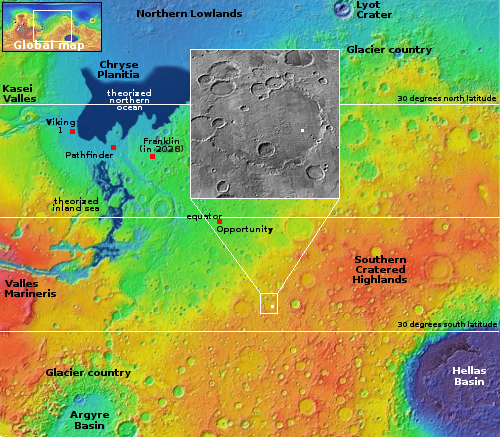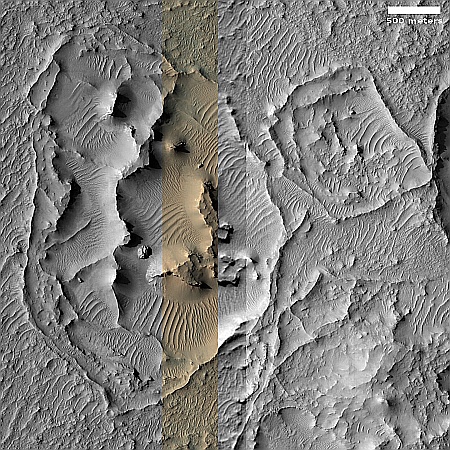Complex ridged terrain in ancient Martian crater
Cool image time! The picture to the right, rotated, cropped, reduced, and enhanced to post here, was taken on January 16, 2024 by the high resolution camera on Mars Reconnaissance Orbiter (MRO). Because an electronic unit for one of this camera’s filters has failed, causing a blank strip in the image center, I have filled in that gap using an MRO context camera image taken October 31, 2015.
The scientists describe this geology as “ridged terrain.” What I see is a surface that was like wet plaster once, and then a giant finger touched it and pulled away quickly, so that as it left some material pulled upward to create random ridges within the depression created by that finger.
These ridges are inside a very very ancient 110-mile-wide crater dubbed Margulis. According to the 2021 poster [pdf] of the scientists who did the first geological mapping of this crater, the crater floor “show remnants of sedimentary materials, suggesting the [crater was] subjected to widespread episodes of resurfacing and denudation.”
Though located in the dry equatorial regions, this ridged terrain suggests it formed suddenly when underground ice sublimated into gas, bursting upward to break the surface when the gas pressure became high enough.

The white dot in the overview map to the right marks the location, in the southern cratered highlands. The inset shows all of Margulis Crater, which is very heavily eroded with at least a half dozen later impacts obscuring its rim and floor.
The ridges themselves are less than thirty feet high. The many parallel small ridges in the hollows are likely dunes, created when sand gets blown into the low points, gets trapped there, and over time the prevailing winds down those hollows produces the parallel ripples.
The extreme age of this crater means it likely comes from the Late Heavy Bombardment during the early solar system, when the many millions of rocks that made of the Sun’s accretion disk were beginning to coalesce into the planets. As they did so they left the surfaces of those planets heavily cratered, which we can see on planets like Mercury and the Moon, which have no atmospheres and have generally remained as they were from that time. Though Mars’ atmosphere and environment is active enough to wipe clean that crater record, it hasn’t wiped it away in the southern cratered highlands where this crater is located.
On Christmas Eve 1968 three Americans became the first humans to visit another world. What they did to celebrate was unexpected and profound, and will be remembered throughout all human history. Genesis: the Story of Apollo 8, Robert Zimmerman's classic history of humanity's first journey to another world, tells that story, and it is now available as both an ebook and an audiobook, both with a foreword by Valerie Anders and a new introduction by Robert Zimmerman.
The print edition can be purchased at Amazon or from any other book seller. If you want an autographed copy the price is $60 for the hardback and $45 for the paperback, plus $8 shipping for each. Go here for purchasing details. The ebook is available everywhere for $5.99 (before discount) at amazon, or direct from my ebook publisher, ebookit. If you buy it from ebookit you don't support the big tech companies and the author gets a bigger cut much sooner.
The audiobook is also available at all these vendors, and is also free with a 30-day trial membership to Audible.
"Not simply about one mission, [Genesis] is also the history of America's quest for the moon... Zimmerman has done a masterful job of tying disparate events together into a solid account of one of America's greatest human triumphs."--San Antonio Express-News
Cool image time! The picture to the right, rotated, cropped, reduced, and enhanced to post here, was taken on January 16, 2024 by the high resolution camera on Mars Reconnaissance Orbiter (MRO). Because an electronic unit for one of this camera’s filters has failed, causing a blank strip in the image center, I have filled in that gap using an MRO context camera image taken October 31, 2015.
The scientists describe this geology as “ridged terrain.” What I see is a surface that was like wet plaster once, and then a giant finger touched it and pulled away quickly, so that as it left some material pulled upward to create random ridges within the depression created by that finger.
These ridges are inside a very very ancient 110-mile-wide crater dubbed Margulis. According to the 2021 poster [pdf] of the scientists who did the first geological mapping of this crater, the crater floor “show remnants of sedimentary materials, suggesting the [crater was] subjected to widespread episodes of resurfacing and denudation.”
Though located in the dry equatorial regions, this ridged terrain suggests it formed suddenly when underground ice sublimated into gas, bursting upward to break the surface when the gas pressure became high enough.

The white dot in the overview map to the right marks the location, in the southern cratered highlands. The inset shows all of Margulis Crater, which is very heavily eroded with at least a half dozen later impacts obscuring its rim and floor.
The ridges themselves are less than thirty feet high. The many parallel small ridges in the hollows are likely dunes, created when sand gets blown into the low points, gets trapped there, and over time the prevailing winds down those hollows produces the parallel ripples.
The extreme age of this crater means it likely comes from the Late Heavy Bombardment during the early solar system, when the many millions of rocks that made of the Sun’s accretion disk were beginning to coalesce into the planets. As they did so they left the surfaces of those planets heavily cratered, which we can see on planets like Mercury and the Moon, which have no atmospheres and have generally remained as they were from that time. Though Mars’ atmosphere and environment is active enough to wipe clean that crater record, it hasn’t wiped it away in the southern cratered highlands where this crater is located.
On Christmas Eve 1968 three Americans became the first humans to visit another world. What they did to celebrate was unexpected and profound, and will be remembered throughout all human history. Genesis: the Story of Apollo 8, Robert Zimmerman's classic history of humanity's first journey to another world, tells that story, and it is now available as both an ebook and an audiobook, both with a foreword by Valerie Anders and a new introduction by Robert Zimmerman.
The print edition can be purchased at Amazon or from any other book seller. If you want an autographed copy the price is $60 for the hardback and $45 for the paperback, plus $8 shipping for each. Go here for purchasing details. The ebook is available everywhere for $5.99 (before discount) at amazon, or direct from my ebook publisher, ebookit. If you buy it from ebookit you don't support the big tech companies and the author gets a bigger cut much sooner.
The audiobook is also available at all these vendors, and is also free with a 30-day trial membership to Audible.
"Not simply about one mission, [Genesis] is also the history of America's quest for the moon... Zimmerman has done a masterful job of tying disparate events together into a solid account of one of America's greatest human triumphs."--San Antonio Express-News


